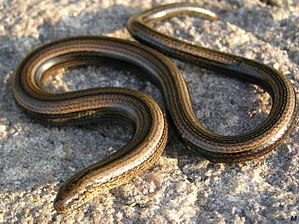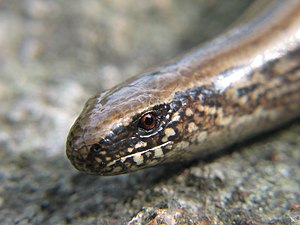 Image via Wikipedia
Image via WikipediaHere's the thing, slow worms have eyelids. Wow! But... how can... wow! With that single fact we immediately have either a very strange and unique snake, or not actually a snake. The latter is the case. Slow worms are in fact a kind of limbless (strange and unique) lizard, and eyelids aren't the only more-lizard-than-snake feature they possess. (By the way, did you know that snakes have no eyelids?)
Some slow worms have visible ears, where no snake does. They can also shed their tail if they are attacked and grow it back later. Pretty drastic, but better than the alternative. If your closer look is also quite long, you might notice that it sheds its skin in patches like lizards do, whereas most snakes slough their scales in one big piece.
This video is adorable! Check out Wildlife Watch UK for more.
They reach about 50 centimetres (20 inches) in length and can be found burrowing in the soil and under logs in Britain, Europe and western Asia. Slow worms are active mostly at night and twilight, just the right time for them to eat slugs and worms, but they don't have that snake ability to open their mouths impossibly wide. Instead, they chew their food and politely swallow, just as their mother told them to. Except that they don't have lips, so it probably doesn't look so good at the dinner table.
 Image via Wikipedia
Image via WikipediaI'll finish up by mentioning that slow worms aren't worms and aren't particularly slow. Where on earth do people get these names from?

You have very quickly become one of my favorite blogs. I am totally fascinated.
ReplyDeleteShucks. Thank you so much! Quite a lot of the credit has to go the actual animals though!
ReplyDeleteInteresting? How closely are they related to snakes? Where to they fit on the Reptilian chart? Trying to ponder their evolution!
ReplyDeleteHi bill. They really are lizards, closely related to more lizards that have no legs and some others that do. They aren't particularly related to snakes. No more than any other lizard, anyway.
ReplyDeleteThere are other lizards called skinks. Some of them have normal big legs, others have long, slim bodies and teeny tiny legs, others barely have legs at all. That's what happened to the slow worm.
Thanks for the interest!
I keep finding slow worms in my house, so far 6 in 2 and a half weeks. This is a huge phobia of mine how can i prevent this as im not coping and keep having anxiety attacks.. i know they cant harm you but i cant help my phobia :( please help
ReplyDeleteThat's strange, I don't know why they'd be coming into your house so much.
ReplyDeleteI can't say much except that there are ways of helping out with phobias. I guess stumbling into a Slow Worm in your own home is about the worse it can get; dealing with phobias is a step by step task but it can certainly be done
hi
ReplyDelete